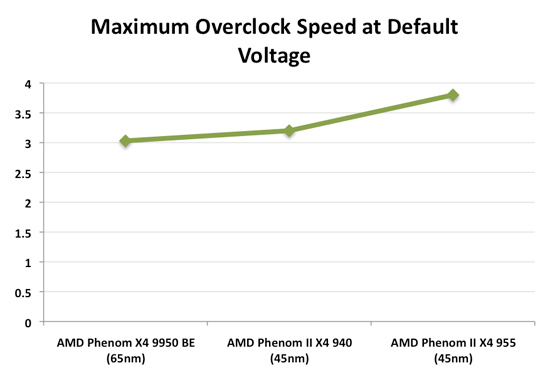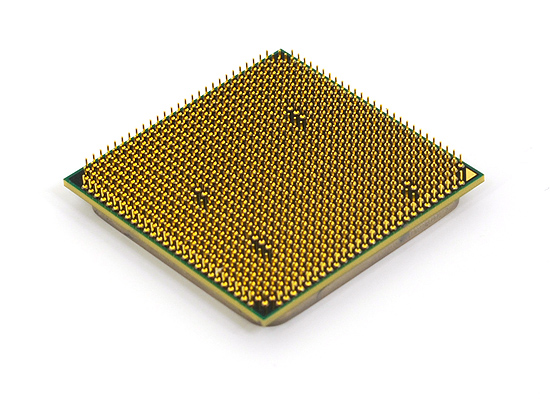AMD's Phenom II X4 955 Black Edition
by Anand Lal Shimpi on April 23, 2009 12:00 AM EST- Posted in
- CPUs
Die size hasn’t changed, clock speeds barely went up, and performance per clock also remained static. But what’s this?

Ah yes, AMD is improving its 45nm manufacturing process and today we have the latest incarnation of AMD’s 45nm silicon.
The first versions of AMD’s 45nm Phenom II couldn’t really go much higher than the final 65nm Phenom without increasing voltage. By comparison, Intel’s Core i7 920 could go from 2.66GHz all the way up to 3.80GHz without so much as a single extra millivolt in our tests.
This new Phenom II however can also hit 3.80GHz without increasing the core voltage. At least that’s what one of our samples did in our testing. Whether it’s 3.8GHz or 3.6GHz, the fact of the matter is that AMD’s 45nm process is improving and that’s what’s behind todays introduction of the Phenom II X4 955. Architecturally the Phenom II hasn't changed; if you're curious about what makes these things tick, please look at our original article on the CPU.


Clocked at 3.2GHz with a 2.0GHz un-core (or North Bridge) frequency, the 955 isn’t that much different from the 940 in terms of clock speed. The two face off in the table below:
| CPU | Clock Speed | un-core Clock (NB Frequency) | Die Size | Transistor Count | TDP | Socket |
| Phenom II X4 955 | 3.2GHz | 2.0GHz | 258 mm2 | 758M | 125W | AM3 or AM2+ |
| Phenom II X4 940 | 3.0GHz | 1.8GHz | 258 mm2 | 758M | 125W | AM2+ |
This is a Socket-AM3 part, meaning it can work in both DDR2 based Socket-AM2+ motherboards and DDR3 based Socket-AM3 motherboards. There’s a huge compatibility caveat about AM2+ support but I’ll address that shortly. The Phenom II X4 955 is also a Black Edition part, meaning it has an unlocked clock multiplier for easy overclocking.

Along with the 955 there’s also a 945 being introduced today. The 945 is identical to the 940 in core clock speed but has a 2.0GHz un-core and is also AM3 compatible.
| Processor | Clock Speed | un-core Clock | L2 Cache | L3 Cache | TDP | Price |
| AMD Phenom II X4 955 BE | 3.2GHz | 2.0GHz | 2MB | 6MB | 125W | $245 |
| AMD Phenom II X4 945 | 3.0GHz | 2.0GHz | 2MB | 6MB | 125W | $225 |
| AMD Phenom II X4 940 BE | 3.0GHz | 1.8GHz | 2MB | 6MB | 125W | $225 |
| AMD Phenom II X4 920 | 2.8GHz | 1.8GHz | 2MB | 6MB | 125W | $195 |
| AMD Phenom II X4 910 | 2.6GHz | 2.0GHz | 2MB | 6MB | 95W | $??? |
| AMD Phenom II X4 810 | 2.6GHz | 2.0GHz | 2MB | 4MB | 95W | $175 |
| AMD Phenom II X4 805 | 2.5GHz | 2.0GHz | 2MB | 4MB | 95W | $??? |
| AMD Phenom II X3 720 BE | 2.8GHz | 2.0GHz | 1.5MB | 6MB | 95W | $145 |
| AMD Phenom II X3 710 | 2.6GHz | 2.0GHz | 1.5MB | 6MB | 95W | $125 |
| AMD Phenom 9950 | 2.6GHz | 2.0GHz | 2MB | 2MB | 140W | $173 |
The prices are pretty attractive; the 955 will sell for $245 (and it already has been) and the 945 will go for $225. That pits the 955 against Intel’s Core 2 Duo Q9550 ($266) and the Core i7-920 ($284), the latter having a much higher motherboard cost of course.
| Processor | Price |
| Intel Core i7-920 (2.66GHz) | $284 |
| Intel Core 2 Quad Q9650 (3.00GHz) | $316 |
| Intel Core 2 Quad Q9550 (2.83GHz) | $266 |
| Intel Core 2 Quad Q9400 (2.66GHz) | $213 |
| Intel Core 2 Quad Q8400 (2.66GHz) | $183 |
| Intel Core 2 Quad Q8300 (2.50GHz) | $183 |
| Intel Core 2 Quad Q8200 (2.33GHz) | $163 |
And you know how I love spoiling surprises so here you have it. Unless you’re running applications that are very well optimized for Intel’s architectures, the Phenom II X4 955 is faster than the Core 2 Quad Q9550. Compared to the Core i7-920, it loses hands down although the chip does come close in some games.
Sorry, I’m not much of a tease :) Now for the rest of the article.










65 Comments
View All Comments
Procurion - Thursday, April 23, 2009 - link
Cool. My next question would be to wonder why it didn't kick in for the other tests? I guess it wasn't enabled for them? Looks good overall.JarredWalton - Thursday, April 23, 2009 - link
See page 4 - Turbo mode tends to activate pretty much any time a load is on the CPU. But it's not really "unfair" as all i7 users get that benefit without doing anything extra, plus i7 chips still overclock far beyond that point.ChemicalAffinity - Thursday, April 23, 2009 - link
Best post ever.whatthehey - Thursday, April 23, 2009 - link
Congratulations on the cryptic post... or is that pointless post? I'm guessing you're suggesting that the words listed were used with two different companies - AMD and Intel - but if so they certainly weren't used in this article in any way I can see. Care to enlighten the rest of us on the point of your comment?Some people are too clever for their own good; others merely think they're clever. Guess which one you are.
Lokinhow - Thursday, April 23, 2009 - link
Oh man, I thinking about the OC3.9GHz on Vista x64
4.2GHz on Vista x86
Why it happens?
Does the results are the same using XP x86/x64 and Windows 7 x86/x64?
That would be interesting to see if it is possible to reach 4.2GHz on Windows 7 x64
Griswold - Thursday, April 23, 2009 - link
Dont hold your breath. Theres more registers (etc) in use under a 64bit OS than a 32bit one. Its highly unlikely that there will be any difference on the exact same hardware. And even if there is a difference between xp/vista/7, 32bit 7 will outdo 64bit 7 as well. 64bit was never the ideal choice for overclocking records...Spoelie - Thursday, April 23, 2009 - link
In the CS4 test, given the large increase in performance when just going from DDR2 to DDR3, would a faster NB clock (2->2.6/2.8ghz) and faster than DDR1333 memory, while keeping the core at default clock, level the playing field with the core2 processors?Seems that in this particular test the phenom is starved for data.
duploxxx - Thursday, April 23, 2009 - link
why do you use these 1GB dimm's in ddr3 config? I would assume you have more oc issues with 4 dimms in stead off 2 dimms?G.Skill DDR2-800 2 x 2GB (4-4-4-12)
G.Skill DDR2-1066 2 x 2GB (5-5-5-15)
Qimonda DDR3-1066 4 x 1GB (7-7-7-20)
Corsair DDR3-1333 4 x 1GB (7-7-7-20)
Holly - Thursday, April 23, 2009 - link
Nice article :-)btw... last paragraph on the first page... "faster than the Core 2 Duo Q9550." should say "faster than the Core 2 Quad Q9550."
ibm386 - Sunday, June 27, 2010 - link
Intel and Amd are owned by the same person. Since a person can't have monoply in U.S. It has been divided into two different names and obviously diff. CEOs.cheers.